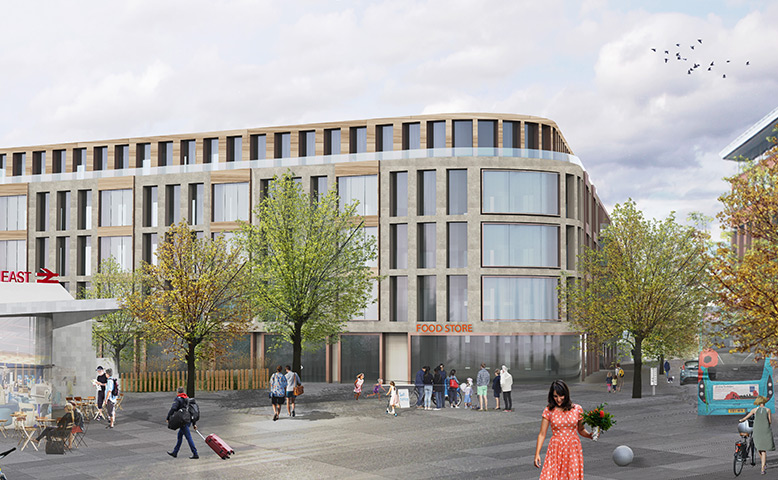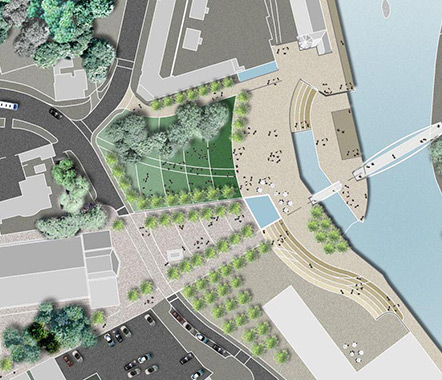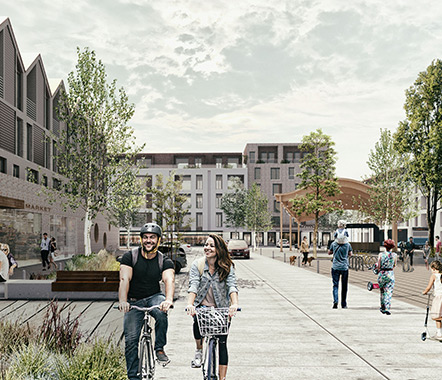
Repurposing of retail assets often requires a whole town approach
Our clients often come to our Urban Design Studio and ask for a masterplan for a vacant or underperforming site. One of the first questions we ask is what is the role of the site within the wider urban context and future vision of the whole town centre. It is important for the success of the development to fully appreciate the opportunities the site offers and the relationship and role it has to play in the rest of the town centre. A successful town centre is made up from many connected parts of activities, character, streets and spaces. Understanding how the sum of all of the parts of a centre can work together is the key to creating a successful distinctive thriving place. Locating uses so that they can work together to increase footfall and the overall draw and success of the town.
City Visions
A tried and tested approach to the regeneration of urban centres is the creation of strong long-term visions. Successful visions need to be based upon sound principles of place making and aim to utilise the assets that already exist, and then enhance and re-connect them as a series of complementary neighbourhoods or “urban quarters”. One of the early champions of this approach was Birmingham city centre, which, in the early 1990s, set out a clear plan to break its “concrete collar” of urban highways and develop a series of new distinctive city quarters, which included the Jewellery Quarter, Gun Quarter, Digbeth and City Centre Core. This initiative has reinvigorated the city centre brand and more recently the initiative has been expanded beyond the core as part of the 2011 City Big Plan.
Town centre brand
At Savills we have taken a similar approach for a number of urban sites, to create added value by demonstrating the ability of development to form part of a much larger integrated approach for a wider town centre vision. Kettering is an example where a struggling town centre needed to change perceptions and begin to regenerate a number of underperforming and vacant sites. Savills view was not to focus on the component part but examine the whole to enhance the opportunities of the centre. Savills developed a strategy to determine how each part of the town centre could work together to create a critical mass of interconnected developments utilising a series of Urban Quarters such as the Market Place, Civic Quarter, High Street, and The Lanes. All of these sites were bound together by a public realm and wayfinding improvements. This approach to identifying a complementary role for each part of the town centre, along with major public realm enhancements, all worked together to create a much stronger brand for the town centre. Similar approaches have also been advocated for places such as Bournemouth, Derby and Maidstone.
Maidstone is a prime example where a number of vacant and underperforming sites, and the draw of three retail zones, all have the result of reducing the spread of footfall across the town centre. Our advice has been to work with the Council at introducing further mixed-use and residential schemes on key sites, as well as exploring ways in which unique qualities of Maidstone can be enhanced to improve the image of the town.


Making better use of the town’s qualities
Of particular note is the ability for further riverside development along the River Medway, an underutilised asset to the town. The town also has the benefit of three mainline rail stations, however each also misses out on opportunities to create positive arrival points and gateway destinations, with restricted access points for pedestrians, and lack of quality facilities, public realm and townscape. We have advised on how these stations can interact better with the town centre, with new development with a range of facilities and accommodation. Such an approach will have the benefit of creating desirable arrival points into the town centre, further enhancing perceptions for visitors.
Further decisions will need to be taken regarding the way in which the brand of the town centre can be enhanced, and the BID initiative will help to focus on a long-term strategy for the town centre. Furthermore, the retail core will also need to look further into increasing the diversity of uses to ensure that the heart of the community adapts and prospers.
Visioning – the way forward
As retail within our urban centres becomes less dominant, it is important to rationalise and avoid overly competing neighbourhoods. We need to look for placemaking interventions that deliver an integrated town centre brand, which incorporates complementary uses that act in unison to draw people back into our centres, and sell local distinctiveness with a range of activities. This will help to increase local dwell time, and encourage vibrancy at the heart of our communities. Above all it is important to have a strong long term vision for our urban centres.

